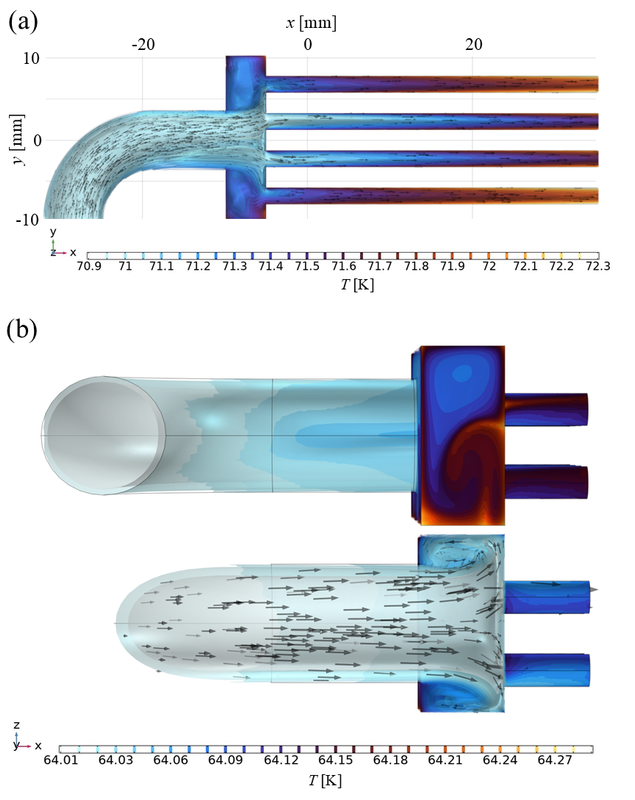Speaker
Description
Cryogenic terminals are critical thermal interfaces in superconducting power systems, where precise temperature control has a direct impact on system stability and performance. This work presents a multiscale thermal modeling framework for LN$_2$-cooled conduction terminals with integrated heat exchangers (HXs), developed to support robust component design under realistic operating conditions (see Figure 1). It builds upon the modeling approach presented by Gačnik et al. [I] and expands it into advanced thermal simulation tools.

The analysis combines analytical modeling, CFD-informed simulations, and semi-empirical methods to resolve internal temperature profiles driven by axial heat conduction and turbulent convective cooling. Particular focus is given to the temperature-dependent thermal and electrical properties of materials, along with localized ohmic heating and its effect on axial temperature gradients. These factors significantly influence the heat transfer efficiency between the solid HX and the subcooled liquid nitrogen (LN$_2$).
Three analytical formulations based on analytical framework of Chang et al. [II], the General Model (G.M.), Averaged Model (A.M.), and Wiedemann-Franz Model (W.-F.M.), were compared to predict cold-end heat loads in copper current leads. The G.M., which accounts for temperature-dependent material properties and axial redistribution of heat, revealed that commonly used simplified models (A.M., W.-F.M.) can overestimate cold-end heat loads by more than an order of magnitude in high-current regimes. At 1300 A input current, A.M. and W.-F.M. overpredicted the cold-end heat load by factors of ~12 and ~16, respectively (52.5 W and 69 W vs. 4.4 W for G.M.), clearly highlighting the importance of spatially resolved conduction effects. This discrepancy may lead to design choices that appear thermally optimized but ultimately underperform due to internal heat redistribution.
CFD simulations of a representative HX geometry were conducted using COMSOL Multiphysics® to capture conjugate heat transfer and cryogenic flow behavior (Figure 2). Calibration of the turbulent Prandtl number (Pr$_T$ ≈ 0.85), which governs the ratio between momentum and thermal diffusivity in the turbulent flow k–ε RANS model [III], enabled accurate reproduction of local temperature profiles and revealed pronounced asymmetries in convective cooling, especially in regions with high velocity gradients and non-uniform heating. These insights supported the development of semi-empirical models capable of generalizing thermal performance across various HX geometries, offering rapid and physically consistent evaluation without relying on full resolution of high-fidelity CFD simulations. This approach also revealed a counterintuitive phenomenon: under specific conditions, the copper structure locally cools the LN$_2$ flow due to strong axial conduction and steep spatial temperature gradients.

To support broader adoption and research reproducibility, the modeling framework has been implemented in TCCBuilder®, an open-source simulation platform for cryogenic thermal control circuits (TCCs) [IV]. The tool enables modular evaluation of LN$_2$-cooled terminals with temperature-dependent material properties and supports the integration of other key components, including thermal diodes, regulators, and switches.
This modeling framework provides a physically grounded understanding of conduction-convection interplay in cryogenic terminals and adjacent HXs, offering predictive capability for both early-stage design and system-level integration. The results emphasize the importance of accurately evaluating internal temperature profiles across all components to prevent thermal bottlenecks, ensure reliable LN$_2$ cooling under steady-state and transient conditions, and mitigate operational instabilities or thermal runaway in superconducting applications.
[I]: Gačnik, D., ter Brake, M., & Dhallé, M. (2025). Thermal modeling of LN₂-cooled terminals with integrated heat exchangers for superconducting applications. Applied Thermal Engineering, 279, 127491.
[II]: Chang, H.-M., & Kim, M. J. (2009). Optimization of conduction-cooled current leads with unsteady operating current. Cryogenics, 49(5), 210–216.
[III]: Yang, X., & Yang, L. (2022). Numerical study of entropy generation in fully developed turbulent circular tube flow using an elliptic blending turbulence model. Entropy, 24(2), 295.
[IV]: TCCBuilder. (2024). Thermal Control Circuit Builder: Open-source simulation tool for thermal circuit design. Retrieved August 28, 2025, from https://tccbuilder.org/.
| Submitters Country | Slovenia |
|---|---|
| Are you a student? | No |
| Author Affiliations & Email Addresses | I confirm that valid email addresses and affiliations have been added for all co-authors. |
| Co-Author Affirmation | By clicking here, I, the submitting author, affirm that all co-authors know of and concur with the submission of this abstract. |
